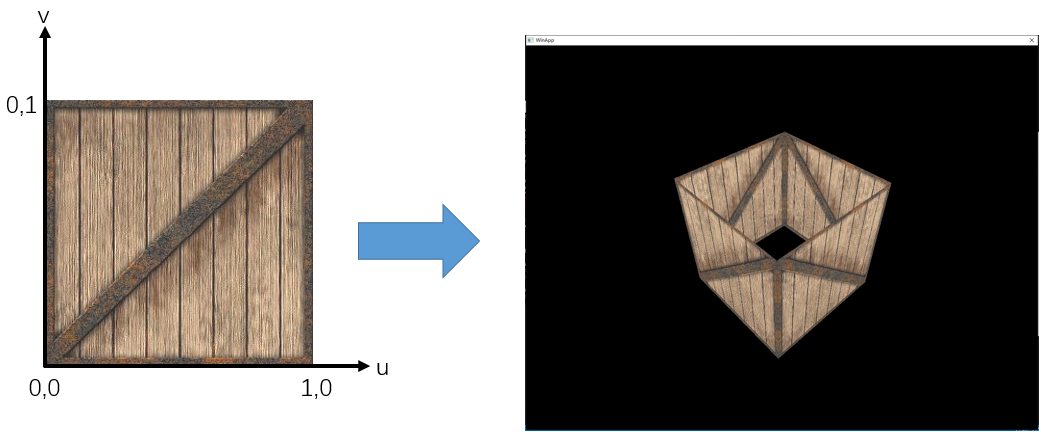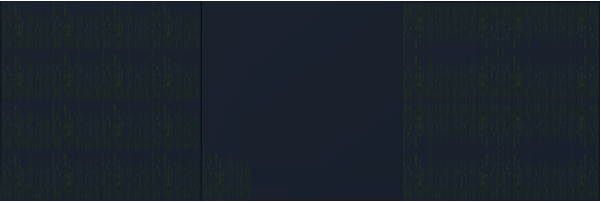之前的小节,我们显示了使用木箱子外观的三角形,纹理可以极大丰富物体的表现,在这节中,我们将介绍一张图像是如何做为纹理进行显示的,最终实现下图效果:

首先,我们拥有一张.tga格式的图片,tga文件头结构如下:
1 #pragma pack(1) 2 typedef struct 3 { 4 char identsize; // Size of ID field that follows header (0) 5 char colorMapType; // 0 = None, 1 = paletted 6 char imageType; // 0 = none, 1 = indexed, 2 = rgb, 3 = grey, +8=rle 7 unsigned short colorMapStart; // First colour map entry 8 unsigned short colorMapLength; // Number of colors 9 unsigned char colorMapBits; // bits per palette entry 10 unsigned short xstart; // image x origin 11 unsigned short ystart; // image y origin 12 unsigned short width; // width in pixels 13 unsigned short height; // height in pixels 14 char bits; // bits per pixel (8 16, 24, 32) 15 char descriptor; // image descriptor 16 } TGAHEADER; 17 #pragma pack(pop)
第1行和第17行的作用将头结构按1字节内存对齐,然后进行文件读取,获取到图像的颜色数据:
1 bool CTGAImage::Load(const char *filename) 2 { 3 FILE *pFile; // File pointer 4 short sDepth; // Pixel depth; 5 6 // Attempt to open the file 7 pFile = fopen(filename, "rb"); 8 if (pFile == NULL) 9 { 10 printf("Openfile %s failed\n", filename); 11 return false; 12 } 13 // Read in header (binary) 14 fread(&_TgaHeader, 18 /* sizeof(TGAHEADER)*/, 1, pFile); 15 16 // Get width, height, and depth of texture 17 _Width = _TgaHeader.width; 18 _Height = _TgaHeader.height; 19 sDepth = _TgaHeader.bits / 8; 20 21 // Put some validity checks here. Very simply, I only understand 22 // or care about 8, 24, or 32 bit targa's. 23 if (_TgaHeader.bits != 8 && _TgaHeader.bits != 24 && _TgaHeader.bits != 32) 24 { 25 return false; 26 } 27 // Calculate size of image buffer 28 _ImageSize = _TgaHeader.width * _TgaHeader.height * sDepth; 29 30 // Allocate memory and check for success 31 _pData = (unsigned char *)malloc(_ImageSize * sizeof(unsigned char)); 32 if (_pData == NULL) 33 { 34 return false; 35 } 36 // Read in the bits 37 // Check for read error. This should catch RLE or other 38 // weird formats that I don't want to recognize 39 if (fread(_pData, _ImageSize, 1, pFile) != 1) 40 { 41 free(_pData); 42 _pData = NULL; 43 return false; 44 } 45 46 // Set OpenGL format expected 47 switch (sDepth) 48 { 49 #ifndef OPENGL_ES 50 case 3: // Most likely case 51 _Format = BGR; 52 break; 53 #endif 54 case 4: 55 _Format = BGRA; 56 break; 57 case 1: 58 _Format = LUMINANCE; 59 break; 60 default: // RGB 61 // If on the iPhone, TGA's are BGR, and the iPhone does not 62 // support BGR without alpha, but it does support RGB, 63 // so a simple swizzle of the red and blue bytes will suffice. 64 // For faster iPhone loads however, save your TGA's with an Alpha! 65 #ifdef OPENGL_ES 66 for (int i = 0; i < lImageSize; i += 3) 67 { 68 GLbyte temp = pBits[i]; 69 pBits[i] = pBits[i + 2]; 70 pBits[i + 2] = temp; 71 } 72 #endif 73 break; 74 } 75 76 // Done with File 77 fclose(pFile); 78 79 return false; 80 }
上面的代码读取8位、16位和32位图像的头信息并进行赋值,然后获取实现的颜色数据地址,根据头信息中的位数,获得图像的模式,由于iPhone不支持BRG格式,这里对gles下的使用作了RGB的转换。现在已经有用于显示的图像的颜色数据,现在定义一个用于软件渲染的纹理类如下,类中Image类包含了一张图像的头信息和颜色数据,在模型初始化的阶段,将这张纹理做为渲染器的输入数据进行传递,同时顶点数据需要传入纹理坐标。
1 class CSoftTexture2D : public ITexture 2 { 3 public: 4 CSoftTexture2D(const char *fullName); 5 Color GetPixel(const Vector2f &uv) const; 6 Color GetPixel(int x, int y) const; 7 private: 8 IImage *_Image; 9 };
在渲染过程中的片断着色器处理阶段,通过使用插值计算得到当前片断的uv值,就可以对纹理数据进行采样了,我们的Shader代码如下:
1 typedef map<string, vector<float>> UniformMap; 2 3 static void VertexShader(const void *globalUniforms, const void *uniforms, const void *datas, unsigned char *out) 4 { 5 UniformMap globalU = *((UniformMap *)globalUniforms); 6 UniformMap u = *((UniformMap *)uniforms); 7 Matrix4x4f mvpMat4(u["mvpMat"].data()); 8 9 const Vector3f &inPosition = *(Vector3f *)(datas); 10 const Vector2f &inUV = *(Vector2f *)(&inPosition + 1); 11 12 Vector4f &outPosition = *(Vector4f *)out; 13 Vector2f &outUV = *(Vector2f *)(&outPosition + 1); 14 outPosition = mvpMat4 * Vector4f(inPosition.x, inPosition.y, inPosition.z, 1.0f); 15 outUV = inUV; 16 } 17 18 REGISTER_VPROGRAM(VertexShader); 19 20 static Color FragmentShader(const void *globalUniforms, const void *uniforms, ISampler **samplers, const void *datas) 21 { 22 Vector2f &inUV = V2F_UV(datas); 23 24 ISampler *sampler1 = samplers[0]; 25 Color albedo = sampler1->Sample(inUV); 26 return albedo; 27 } 28 29 REGISTER_FPROGRAM(FragmentShader);
在FragmentShader代码中,第25行使用采样器进行采样,在不考虑多重采样等情况下 ,对于BGR格式的图像最简单的采样代码如下,这样,模型上就可以显示出带纹理的外观了。
int width = _Image->GetWidth(); int height = _Image->GetHeight(); if (x >= 0 && x < width && y >=0 && y < height) { unsigned char *data = (unsigned char*)_Image->GetData(); unsigned char *addr = data + width * y * 3 + x * 3; float inv = 1.f / 255.f; return Color(1.f, *(addr + 2) * inv, *(addr + 1) * inv, (*addr) *inv ); }
上面过程介绍了一张图像从加载到显示的过程,展示了纹理的简单应用,然后纹理的作用远不止如此,上面介绍的的是一张2D纹理的使用,在游戏中,纹理还有1D纹理、3D纹理、Cube纹理。1D纹理在卡通渲染中明暗过滤处理比较常见,3D纹理则相当于2D纹理叠在了一起,在体积渲染和一些drawcall合批优化中可以看到相关应用,Cube纹理则可以在天空盒、环境映射中看到它的身影。
通常对一张纹理进行采样,其Wrap Mode通常有Repeat、Clamp、Mirror几种,Wrap Mode是指当纹理坐标是Normalized即0~1时,uv超出这个范围的处理,下图是几种模式的效果图:

上面的例子中,我们没有处理纹理过滤的情况,由于纹理坐标与屏幕分辨率无关,纹理尺寸与模型尺寸的对应需要纹理过滤来处理这种适应关系,通常用到的有Nearest——取最邻近的像素值和Linear——获取附近像素加权平均值,同时当一个模型距离摄像机很远时,可以对纹理使用Mipmap来避免远处的闪烁现象,一张32*32的纹理其Mipmap级别从0到5分别为32*32、16*16、8*8、4*4、2*2、1*1。如果一张纹理启用了Mipmap其占用内存大小约增加1/3,推导如下:
设S = 1/4 + 1/16 + … + 1/(4^n) 为增加的内存大小,
1 + 1/4 + 1/16 + … + 1/(4^(n-1)) == 4S 为总占用内存大小,
4S – S = 3S = 1 – 1/(4^n)
n趋向于无穷大时,3S = 1,因此S = 1/3。
本节介绍了纹理的基础知识,后面介绍完光照后,将继续介绍凹凸映射、环境映射等高级技术,总之,游戏开发很多渲染表现都需要用到纹理相关技术。
原文地址:http://www.cnblogs.com/primarycode/p/16793765.html
